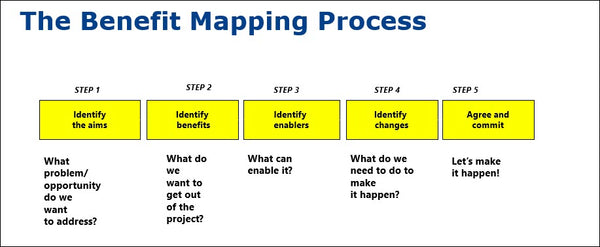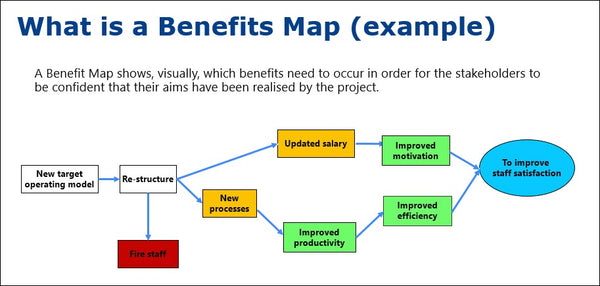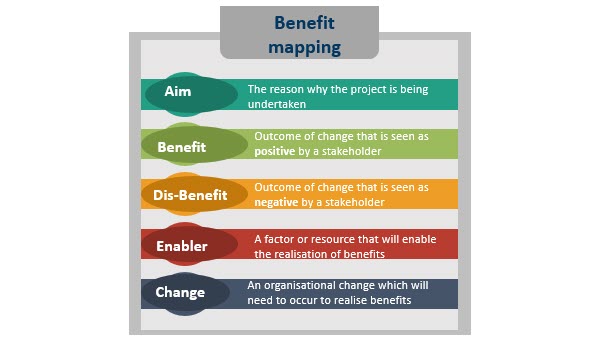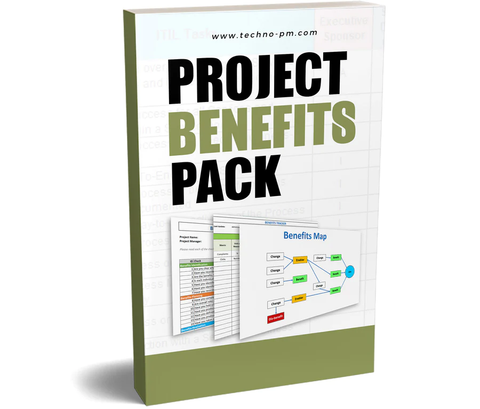Benefits Mapping: Visualizing the Project's Goals and Outcomes
I don’t know about you, but I’d be lost without maps! I’m so thankful for the GPS system, particularly when I’m on holiday abroad – trust me, I can lose my way very easily. The trouble is that this seems to happen too often with organizations and how they deliver benefits from the change initiatives. They had it all planned in an all-singing all-dancing Benefits Management Plan, and after a while or suddenly, those benefits get lost along the way and are nowhere to be found. So I guess they need a map too.

Building a benefits map enables awareness for the next steps on the journey and the critical dependencies to manage. It allows you to start with the end in mind by drawing a path between your as-is state and your to-be state-related benefits. Fortunately, there is a tool out there intended exactly for that, and (surprise!) it is even called “map” – a Benefits Map. As with any good map, it shows you the optimal way to reach your destination (a.k.a. benefits), covering all the key dependencies and showing you where the tolls (think of it as dis-benefits) are.
If you are to be guided by the benefits map, it makes sense to produce it even before you embark on the journey towards the sweet land of benefits. Thus, it should be one of the key artifacts of the benefits planning stage, part of the project planning

The following elements compose a benefits map, which is initiated from the end of the goal, backward:
1.Aims: represent the purpose for the project, its “why” (e.g., “to reduce,” “to increase,” “to improve”). They also define the boundaries for the project scope and should always be identified in relation to the organization’s ultimate strategic objectives.
2.Benefits: refer to what needs to be achieved to achieve the aims. These are captured in Benefits Profiles and can include a variety of types, from operational to financial. They represent a positive impact from change, such as “increased satisfaction of staff” or “reduced waste.”
3.Enablers: as suggested by the name, enablers represent something – a factor or a resource – that facilitates the delivery of the benefits, such as a new tool, a policy, a specialist, or a deliverable from another project. However, it should be stressed that enablers themselves do not realize benefits – changes are required at the organizational level to get there.

The benefits the map provides a visual overview of the information identified during the benefits workshop – i.e., the project aims, benefits, enablers, and changes – and the links between them. While it is usually produced by a benefits specialist, this artifact is ultimately owned by the project sponsor, who has the key accountability for the overall realization of benefits in the project.
Sophisticated software tools for influence/mind mapping are available for the creation of a benefits map, but even if you don’t have one, this should not prevent you from attempting the exercise of mapping – a diagram in a presentation slide or a group of post-its on a wall is as effective!
- If you are still in doubt, have a look at the benefits of having a benefits map:
- It moves the focus from execution and deliverables to strategy and benefits
- It offers a visual and easy-to-understand path on how to realize benefits
- It represents a high-level view of the overall benefits for the project
- It creates ownership for benefits realization and related dependencies
- It indicates the extent of change involved
- It is a powerful communication tool that explains the why of the project.
No, benefits don’t happen out of the blue. While for many organizations, benefits still appear to exist within a black box, surrounded by mystery and uncertainty, there are many forces at play to lead to effective benefits realization. The benefits map reminds us that there are no benefit miracles – but with hard work and proper management, you will not get lost – instead, you will be rewarded with a nice “you have arrived at your destination.”




